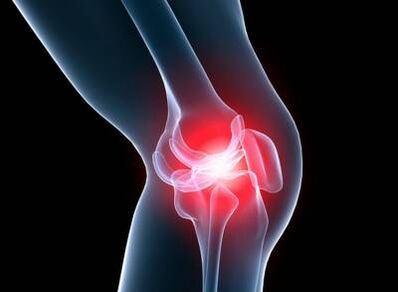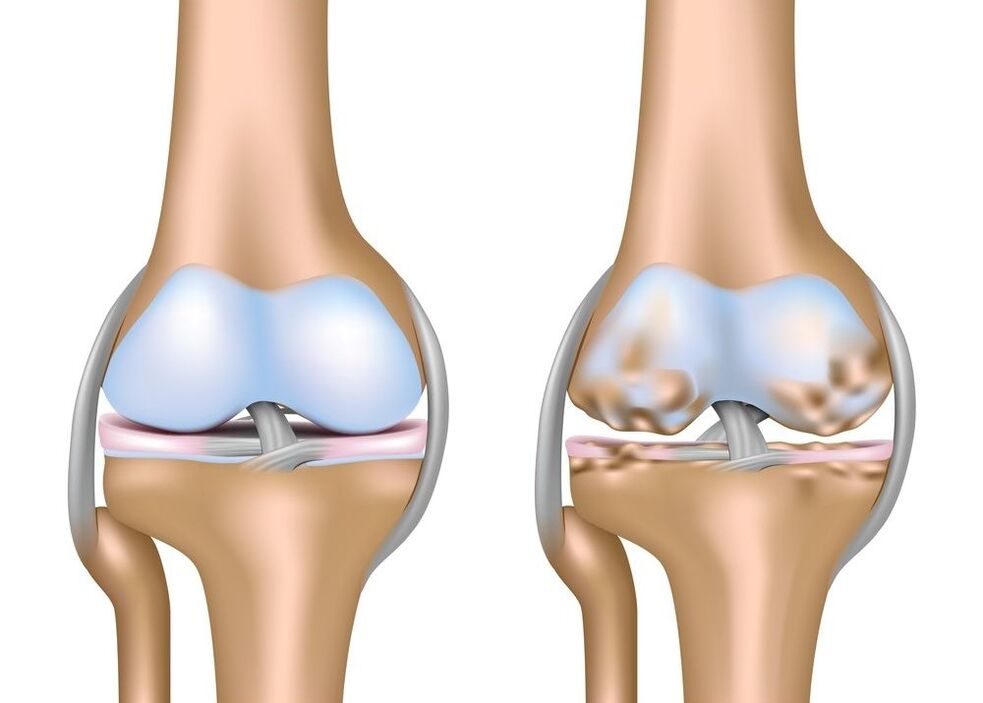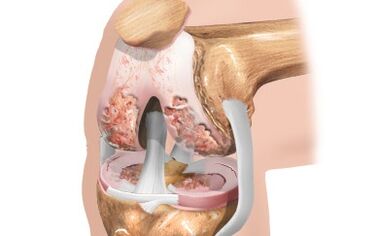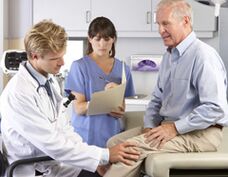The deformation of the arthrosis of the knee joint is a polyhieziological disease. This means that there are many reasons for its development. In some cases, when the most dominant cause can be assigned, gonartrosis is called secondary. In the event that a clear cause is not determined, the diagnosis of primary or idiopathic arthrosis of the knee joint is established.

- deform osteoarthritis of the medial part of the femoral joint;
- deform osteoarthritis of the lateral part of the femoral joint;
- deform the arthrosis of the articulation of the femoral.
Normally, the destruction of the joint cartilage occurs in the process of commensation physiological of the entire body, that is, during aging. The pathological destruction of the cartilage is considered when it occurs in advance or a more intense rhythm. The average age, in which on a completely legitimate basis, the first signs of cartilage degeneration may occur is a period from 40 to 50 years. With the deformation of osteoarthritis, the disease debuts during childhood with the first events of 16-18 years and in some cases even earlier. However, this is not a reason to despair.
The mechanism of the development of the disease is a vicious circle in which the final connections launch the initial and so on the infinity. However, each round of this circle worsens the condition of cartilage and leads to the progression of the disease and so on the chain. In the case of primary gonartrosis, the reason that launches a vicious circle is not known. However, its subsequent ties are carefully studied with the aim of influencing them and slowing down the progression of the disease.
Deforming arthrosis develops approximately as follows. The daily joint cartilage of the knee joint experiences thousands of shocks that are forced to deprecate in order not to damage the most tender structures of the human body, such as the internal organs and the brain. Over time, due to the data of the brain commodities, the microscopic cracks are formed in the cloudy layer, which even after a certain period of time are filled with synovial fluid and are transformed into microdists. Near microdists have a tendency to join and the formation of larger cysts.
The increase in the size of the cysts of the corneal space gradually begins to squeeze the capillaries of the blood that feed the tissue of the cartilage from the side of the bone. The supply of it with oxygen and substances necessary to maintain vital activity, worsens, which leads to a slower synthesis of type 2 collagen.
The transport of the cartilage leads to two negative consequences. Firstly, it leads to a deterioration of amortization properties and a more intense formation of new microcracks in the subsidiary layer. Secondly, due to the compression of the cartilage, its density increases, which negatively affects the second mechanism of its nutrition, the spread of the synovial fluid in the thickness of the cartilage tissue.
However, on the scale of the entire organism, the destruction of the joint cartilage does not go unnoticed. As a compensatory reaction at the center of the washing cartilage, the activity of the condoroblasts - young cells that summarize the new increases in the cartilage tissue. However, this compensatory mechanism is imperfect and its imperfection lies in the fact that most of the cartilage tissue does not forget instead of the greatest destruction of cartilage, but where the cartilage does not experience loads.

As a result, the cone -shaped cartilage growths are formed along the edges of joint condrofites. These chondroofiti do not occur clinically until the ossification processes begin in them. Okreteen, the chondroofites induce and transform into, which are called peaks in ordinary people. As a rule, the appearance of the peaks is always accompanied by the occurrence of the pain and the development of inflammation in the articulation. This is due to the fact that the osteophytes during the movement of the joint touch the fabric of the cartilage and the synovial shell, damaging it mechanically.
Consequently, any complication of the deforming osteoarthritis leads to the acceleration of the progression of pathological changes in the cartilage. However, knowing the development mechanism of gonartrosis, you can successfully influence some of its connections in order to slow down its current and improve a long -term forecast.
Secondary gonartrosis differs from the primary one as the main reason is known, which has launched a vicious circle of destruction of the joint cartilage. The further course of the disease occurs in the same way as primary gonartrosis, with the peculiarity that the disease is constantly aggravated by the effect of negative factors associated with the disease below. For this reason, the course of the secondary arthrosis of the knee joint, as a rule, is more aggressive.
- lesions (acute and chronic);
- congenital varus or valgus deformation of the lower ends;
- Congenital shortening of one of the lower ends;
- Hypermability syndrome of the knee joint;
- congenital dysplasia of the knee joint;
- Condrocalcinosis;
- osteomyelitis;
- rheumatoid arthritis;
- acromegalia;
- diabetes mellitus;
- obesity;
- hypothyroidism;
- Fraud, etc.
Post -traumatic deforming arthrosis is divided into acute and chronic. The acute form of the disease develops after a serious injury, more often -

, which occurs or extends partially to the joint part of the bone. The chronic form of the disease develops for a longer time and is associated, as a rule, with frequent and slight injuries to the joint. These conditions are created by manufacturers, road workers, removals, etc.
In acute gonartrosis, the mechanism of the disease is associated with serious inflammatory changes in the joint cavity, i. e. with lymphostasis, increase in pressure in the joint cavity and a change in the composition of the synovial fluid. The excessive acceleration of the growth of the new cartilage fabric leads to the deformation of the joint surface on the fracture site and the growth of osteophytes.
In chronic gonartrosis, a serious inflammatory process is not observed, however, the frequent and intensive load on the cartilage tissue leads to its rapid compression, the formation of microcrack and the deterioration of the supply of the cartilage with nutrients both on the side of the bone and from the joint gap.
People with this pathology can be found quite often. Its essence is to change the shape of the legs. With the varta deformation, the legs are arched outwards on a horizontal plane. In other words, among the patient's legs, space is more than in healthy people. With the deformation of Valgus, the legs have a shape in the shape of an X when the knees are in contact with each other. Both pathologies can be both genetically programmed and developed throughout life due to the fractures of the lower ends.
In both cases, the load on one of the sides of the knee joint increases, with deformation of the Varus - on the side sides and with the valgus deformation - on the medial sides. Due to the fact that the same weight of the patient pressure on a smaller area, a premature cartilage washing occurs, accompanied by inflammation, pain and morning rigidity.
The conctic shortening of one of the legs is a consequence of the anomalies or can develop a few years after birth following the lesion at birth. As in the previous case, an irregular weight distribution occurs and the normal leg takes on a large load. As a result, the joint cartilage of the knee joint of a healthy leg undergoes structural changes that lead to deforming arthrosis.
This pathological condition is not a disease, but it can bring it. This syndrome means excessive mobility of the binding and coherent system, in which the joint movement of the joints within the normal axes can increase significantly. These patients almost never suspect that they have such a characteristic, since they live with it for life and believe that other people also work in the same way.

A sign of hypersmors of the knee joint is the formation of a stupid corner between the front surfaces of the thigh and the lower part of the leg with the maximum straightening of the leg. In other words, the knees bend, so to speak and the legs take a burning shape. In addition, such patients can easily reach the forearm with the thumb, reach the head to the legs and, in principle, have congenital flexibility.
Symptoms of arthrosis of the knee joint
In the initial phase of development, the pathology manifests itself from knee pain, moderately expressed and deriving while it was in motion, when it moves along the steps.
An unpleasant symptom may appear if a person spends a lot of time standing or tries to go up after being in a sitting position for a long time.
At rest, health usually improves.
A high intense intense pain arises spontaneously.
Most patients previously had prolonged discomfort during physical activity and walking. In this case, growing pain can be the main sign of gonartrosis development.
The disease gradually develops, for several months or years, if not yet a visible deformation and severe pain. But during this period, the discomfort in the knees, which occurs from time to time.
Remember, first consult a doctor, easier and more successful the treatment will pass.
Do not delay a visit to a specialist, waiting for irreversible consequences. Take measures as soon as you notice the symptoms of the disease.
The evident signs of arthrosis of the knee joint begin to manifest themselves as a structure of the cartilage shells, a decrease in the production of synovial fluid and damage to the joint bag. In the initial phase of the increase in pathological changes, as a rule, there are no pronounced symptoms, but at the same time there may be a slight rigidity in the morning.
When the pronounced and various symptoms appear, arthrosis, as a rule, is already in the advanced phase of their development. At the moment, there are already serious damage to the structures of the knee joint, so the disease goes into the acute phase. The characteristic manifestations of the acute development period of osteoarthritis include:
- increase in pain;
- Change of pace;
- zoppa;
- crunch when it moves;
- swelling of soft tissues;
- an increase in the knee due to the accumulation of liquid in it;
- Limit mobility in the joint.

When developing the arthrosis of the knee, the symptoms can grow long enough, but when the disease comes to the last 3 stage of manifestation of an articulation disorder, the quality of life significantly reduces the quality of life.
- The synovial shell against the background of the damage to the joint surfaces begins to inflame, which leads to a violation of the mobility of the entire joint.
- Any movement with a damaged joint can be very painful.
- On palpation, a significant increase in local body temperature is observed.
- As a rule, the effective treatment of arthrosis of the knee joint with conservative methods is possible only in the initial phase of the development of the disease.
- Therefore, when signs of the disease appear, consult a doctor for consultation.
In the development of such a condition such as the arthrosis of the knee, the symptoms and treatment are interconnected, since if in the early stages of the development of the disease, joint surfaces can still be completely restored and improved by the local metabolism, therefore in the subsequent phases the pharmacological treatment of knee arthrosis cannot have a positive effect, since the postcard is so subtle that the structures per bones.
The arthrosis of the 1st degree proceeds almost without visible symptoms. This development phase is characterized by:
- fatigue effort;
- A slight decrease in mobility, which usually observed immediately after sleep.
The symptoms of pain, if they occur, manifest themselves lightly. At this moment, the arthrosis of the knee looks in the X -ray in the form of small bumps on the fabric of the cartilage and on the surface of the bones.
With the arthrosis of the 2nd degree knee joint, the symptoms are more pronounced. The pain already derives from the minimum load or immediately after. In the interested part of the leg, the pain is caused by almost all movements. After a fairly long rest, it usually goes completely. However, the next physical actions immediately cause pain.
In about the second phase of the development of the disease, the sensations of pain are added:
- crunch in the knee joint during the movements;
- A reduced opportunity to just just just kneeling the leg;
- change of joint bones;
- Progressive synovates.
A arthroso crew of joints, as a rule, is first to barely audible, but with the course of the disease it becomes very strong and distinct. When trying to bend the leg in the knee, acute pain occurs. In some cases, this is possible only up to an angle of 90 degrees, therefore with difficulty and overcoming pain. Even the change in the form of the joint becomes evident, which is also aggravated by the accumulation of pathological fluid in it.

The characteristics of the 3rd degree of arthrosis are serious pains that are independent of the quantity, the intensity of physical activity. The joint disturbs a person even at night, this causes a significant inconvenience.
X -ray can show global cartilage changes, joint surface, non -characteristic growths. The curvature in the shape of or in the shape of an X brings a person to the disability. These are the consequences that the cartilage tissue has already consumed and the bone tissue has gone into the "move".
Gonartrosis is a disease of degenerative dyenerative nature, in which the destruction of cartilage occurs and the articulation is deformed. The signs of the disease are severe pain, the deformation of the limbs, an irregular load distribution on the bone-muscular system, the development of complications and a significant reduction in mobility up to the patient's disability.




















